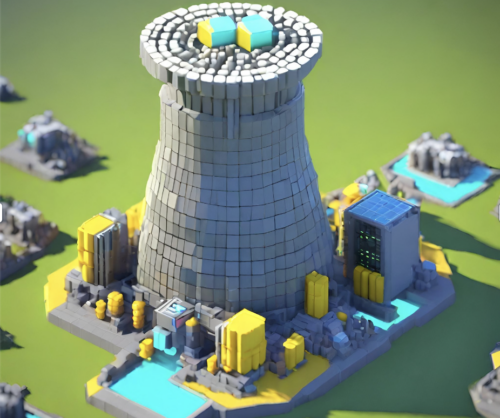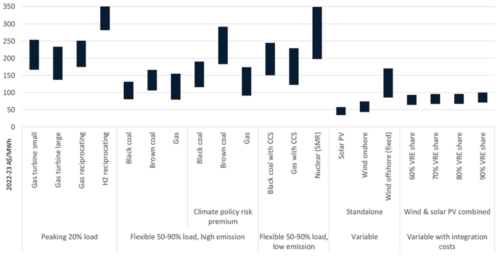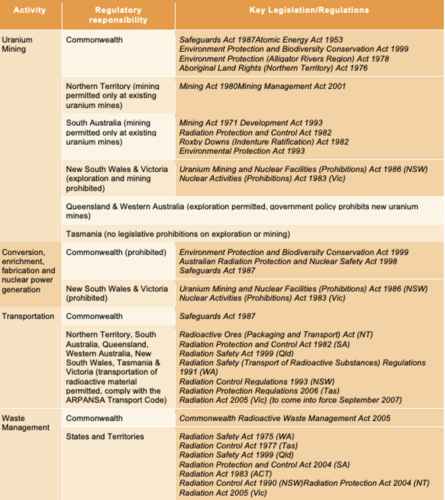

In a rapidly changing world with evolving energy demands, countries are constantly exploring more efficient and sustainable means of power generation. Amidst a surge in renewables, the age-old debate surrounding nuclear energy remains pertinent. This article dives deep into the workings, historical trajectory, and economic implications of nuclear energy, ultimately bringing to light the broad possibilities and challenges in the Australian context.

How It Works
At the heart of nuclear power is the extraordinary process of nuclear fission, where the nucleus of an atom is split into two smaller nuclei, releasing an immense amount of energy. This process is typically initiated by bombarding the nucleus of a heavy atom, such as uranium-235 or plutonium-239, with a neutron.
When a neutron collides with the nucleus of a fissile material like uranium-235, it can cause the nucleus to become unstable, leading it to split into two smaller nuclei, along with the release of additional neutrons. These newly liberated neutrons can then go on to collide with other fissile nuclei, setting off a chain reaction. It’s this self-sustaining chain reaction that lies at the core of nuclear power’s energy generation.
As the fissile material undergoes fission, an enormous amount of thermal energy is generated in the form of high-speed particles and gamma radiation. This intense heat is what sets nuclear power apart as a viable energy source.
Harnessing the Energy: Nuclear Reactors
This is where nuclear reactors come in to transform this heat energy into electricity. These reactors are designed to carefully control the chain reaction, ensuring a steady and manageable release of energy. They are typically composed of several key components:
Nuclear power plants are engineered with meticulous safety measures to prevent overheating, radiation leaks, and reactor meltdowns. These safeguards include redundant cooling systems, containment structures, and emergency shutdown procedures.
Reactors typically come as Boiling-Water Reactors (BWRs) or Pressurised-Water Reactors (PWRs). Within a BWR the reactor core heats water directly within the confines of the reactor vessel, while in a PWR water is heated under pressure and then used to heat an external water source.
Beyond these traditional reactor types is the Small Modular Reactor. These innovative reactors represent a departure from convention, approximately one-third the size of their larger counterparts, facilitating assembly within a factory setting. As SMRs continue to evolve, they hold promise as a pivotal component of the future energy landscape, poised to contribute to sustainable and reliable electricity generation.
Looking Back: The Road to Commercialization
The fascinating tale of nuclear power’s origins can be traced back to a series of pivotal scientific discoveries. It all began with the unearthing of uranium by Martin Klaproth in 1789. However, it was in the early 20th century that scientists like Ernest Rutherford and Niels Bohr made ground-breaking contributions to our understanding of atomic structure and the behaviour of electrons within atoms. These discoveries laid the foundation for the extraordinary energy potential locked within the atom.
As World War II began, the urgency to harness atomic energy for both destructive and constructive purposes escalated. The Manhattan Project in the United States and the efforts of the British MAUD Committee propelled nuclear research forward. The successful testing of atomic bombs in 1945 marked a turning point as efforts shifted towards the peaceful use of nuclear energy. By the mid-1950s, the first commercial nuclear power plants emerged, marking the transition from atomic weaponry to civilian energy production. The Shippingport Atomic Power Station in Pennsylvania, operational in 1958, symbolized the dawn of a new era in electricity generation.
The journey from scientific curiosity to commercial reality was fraught with challenges, but it ultimately paved the way for nuclear power to become a cornerstone of modern energy production. This exploration of nuclear power’s evolution sets the stage for a deeper examination of its economic feasibility and sustainability on a global scale.
State of Play Abroad
Looking abroad, nuclear power plants have played an integral role in shaping the United States’ energy landscape. Since 1990, these plants have consistently contributed approximately 20% of the nation’s total electricity. As of August 1, 2023, the United States boasts a robust nuclear infrastructure, with 93 nuclear reactors operating across 54 nuclear power plants located in 28 states. Among these facilities, 19 host a single reactor, 31 house two reactors, and 4 accommodate three reactors. This extensive network of reactors underscores the nation’s commitment to nuclear energy.
Furthermore, on the global stage, the United States leads the pack in nuclear power generation. In 2021, among the 33 countries with commercial nuclear power plants, the United States claimed the top spot both in terms of nuclear electricity generation capacity and actual generation. With a nuclear electricity generation capacity of 95.49 million kilowatts, it produced a substantial 778.15 billion kilowatt-hours of nuclear electricity.
While nuclear energy constituted 19% of the country’s total electricity generation, it was France that boasted the highest nuclear share globally, comprising an impressive 68% of its total national annual electricity generation. This data underscores the significant role nuclear power plays not just within the United States but also on the international stage, where it continues to contribute substantially to electricity generation and sustainability efforts.
An Integral Part of the Future Local Economy?
Given its capability, nuclear power generation seems like the Goldilocks solution for the challenges facing the local current energy market. It would provide the solution to three key problems facing the energy market given the exit of coal and influx of renewable energy.
First, nuclear energy is a firm source of energy, being able to run 24 hours a day, 7 days a week, much like coal capacity. Given the intermittent nature of renewables, nuclear energy can ensure that there remains sufficient energy during periods of lower renewable output. Moreover, nuclear energy has very low emissions, with various renewable technologies such as solar having a higher carbon footprint over its life. Finally, nuclear technology would require a far smaller buildout of transmission infrastructure, which has been a key roadblock to the pace of the energy transition. Nuclear power plants can be built near existing switchyards and transmission hubs where coal power plants are currently located, such as Lake Macquarie and the La Trobe Valley, saving significant amounts of capital cost and time.
However, these theoretical functionalities have to be ultimately weighed against the economics of this technology in a competitive energy market (such as Australia’s). This underpins the core of the current Government’s continuation of the ban on nuclear reactors in Australia, given all existing costs seem prohibitive. The latest CSIRO LCOE data indicates that Nuclear Small Modular Reactors would have a levelized cost of energy of $200-350/MWh, which is far higher than both existing electricity prices and the levelized cost of renewable energies or various forms of firming. These prohibitive costs would suggest that the technology is entirely uneconomic in nearly all energy market scenarios.
CSIRO GenCost Levelised Cost of Energy (A$/MWh)
 Source: CSIRO
Source: CSIRO
While the various similarities between nuclear and coal-fired power add to its appeal, nuclear energy also suffers the same economic pitfalls that result in coal-fired assets exiting the market. Australia’s electricity “duck curve” results in baseload forms of energy such as coal and nuclear being exposed to low or sometimes even negative prices during the day. The “duck curve” phenomenon is driven by the significant proliferation of rooftop solar technology in Australia, whereby excess solar capacity is exported to the grid through households’ electricity retailers. This often results in an excess supply of energy during the day, pushing prices negative. Due to the inflexibility of these forms of generation, which can ramp down to ~50% of its nameplate capacity (similar to the Eraring and Bayswater black coal plants), their economics are significantly strained by exposure to these lower prices (relative to other forms of variable firm capacity such as gas-fired generation). Given the higher fuel costs for nuclear energy relative to cheap black and brown coal, Nuclear’s higher Short-Run Marginal Cost would leave it even more vulnerable to negative prices than even existing coal assets.
The primary economic issue is the unknown capital cost of modern nuclear technologies. There remain no examples of operating small modular nuclear reactors in the world, with projects currently in construction in the last few years. The most optimistic breakeven costs for these projects are now more than US$100/MWh. While this is potentially possible in regulated electricity markets such as the United States, the costs of small modular reactors cannot currently match Australia’s existing generation technology costs. While there remains significant potential for costs to fall over time, the long lead time likely results in at least 7-8 years between the time at which reactors are ordered to their first operation. Therefore, nuclear technology is likely now unable to play a role in Australia meeting 2030 targets for renewable generation.
Nuclear reactors are much more common in other jurisdictions, such as the US and EU. To some degree, geographical differences in the EU necessitate more nuclear generation capacity than in Australia. Worryingly, most of the capacity growth in Europe is currently under cost overruns and delays, which highlights the difficulty in executing the construction of cost-effective nuclear energy. Ultimately, we see nuclear as more challenging in Australia than in the EU given the far more cost-effective options of renewables with firming gas than Nuclear, given better renewable resources and lower gas prices in Australia than in Europe.
The Legal and Political Atmosphere
Two main pieces of federal legislation prohibit nuclear power: the ARPANS Act 1998, and the EPBC Act 1999. However, there is a much larger collection of legislation that regulates or prohibits the different processes in the nuclear fuel cycle, complicating the potential legalisation and creation of a nuclear energy industry in Australia. Virtually every inquiry into the viability of nuclear power has returned the same result: it is supposedly economically unviable.
Nonetheless, this conclusion is largely derived from the findings of the GenCost report which uses outdated data on the cost of nuclear technology and utilises potentially erroneous assumptions. There is a paradoxical circular reasoning evident in this context. The accurate pricing of nuclear power cannot be achieved under a ban and thus government inquiries use flawed estimates to determine that the cost of nuclear power is too high. This conclusion reinforces the notion that there is no reason to repeal the ban on nuclear power given its purported economic challenges. This reasoning cycle depicts the issue’s complex nature and the interconnection between forecasting, conclusions, and current policy.
Recently, pronuclear policy has been championed by David Limbrick of the Libertarian Party in Victoria, but there has also been a push from the Liberal Party, propelled by the AUKUS deal. However, pronuclear policy is at a standstill for the foreseeable future given the Labor Party’s unwavering commitment to upholding the ban, in conjunction with the Liberal Party’s inability to gain favour from the public as of recent.
Nuclear Legislation: Australia

Source: Australian Parliament House
Near Success Followed by Repeat Failure
John Gorton’s government marginally missed out on the establishment of the first nuclear power plant in the 1970s, owing to the succeeding Whitlam government’s shelving of the project. In 1998, five regimes later, John Howard’s government agreed to a Greens proposal that forbade the development of new nuclear facilities. In a twist to this position, in 2006 Howard called for a debate on the establishment of a nuclear power industry, with then Opposition Environment Spokesman Anthony Albanese dubbing Howard’s nuclear policy “Australia’s nightmare”.
The next ten years or so saw little attention and debate over nuclear policy until South Australia conducted its ‘Nuclear Fuel Cycle Royal Commission’ in 2015. The Commission delivered its final report in 2016, ultimately determining that nuclear energy would be too costly and thus not commercially viable. South Australia’s effort was echoed by Victoria four years later, with Victoria’s Legislative Council referring a motion for the Environmental and Planning Committee to investigate the benefits of repealing the Nuclear Activities (Prohibitions) Act 1993. In 2020, the committee declared that nuclear power would be economically unviable for the foreseeable future without subsidisation yet acknowledged that accurate price forecasting was not possible with a moratorium in place.
Social Licence
The idea of nuclear energy often evokes memories of the disastrous reactor meltdowns at Chornobyl (1986) and Fukushima (2011), perpetuating a poor first impression of nuclear, and disregarding the significant developments in nuclear technology. Yet, domestic polling on the topic of nuclear energy has witnessed a rising pro-nuclear public endorsement, with a Lowy Institute poll (2022) reporting 52% of Australians favour overturning the nuclear power ban. A 2023 Q+A audience poll similarly reported that 59% of Australians support lifting the nuclear energy ban, likely boosted by the AUKUS deal involving the acquisition of a nuclear-powered submarine. Results from different polls on the subject of nuclear power have yielded differing results, likely attributable to how the question is framed. Nevertheless, Australia’s transition to the sustainable production of energy in hopes of a net zero future, along with rising energy prices, has catalysed growing public interest in nuclear as a source of energy.
Conclusion
The discourse surrounding nuclear energy is layered and deeply rooted in the intricate interplay of economics, politics, and environmental imperatives. While the technology behind nuclear is undeniably impressive, the economic viability, especially in the Australian energy landscape, raises valid concerns. Looking forward, the integration of nuclear energy into Australia’s power portfolio hinges on technological advancements, cost reductions and a paradigm shift in both political and public perception.
The CAINZ Digest is published by CAINZ, a student society affiliated with the Faculty of Business at the University of Melbourne. Opinions published are not necessarily those of the publishers, printers or editors. CAINZ and the University of Melbourne do not accept any responsibility for the accuracy of information contained in the publication.